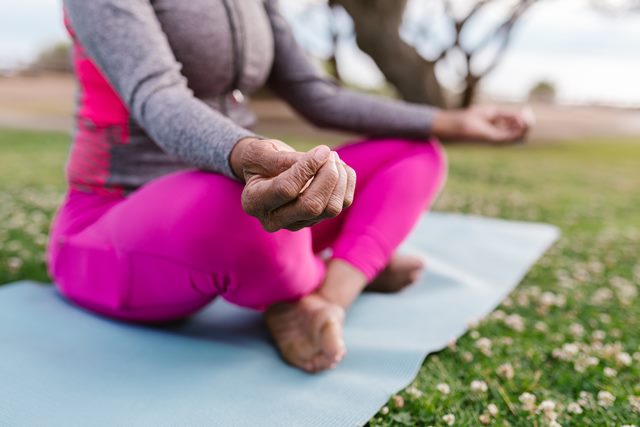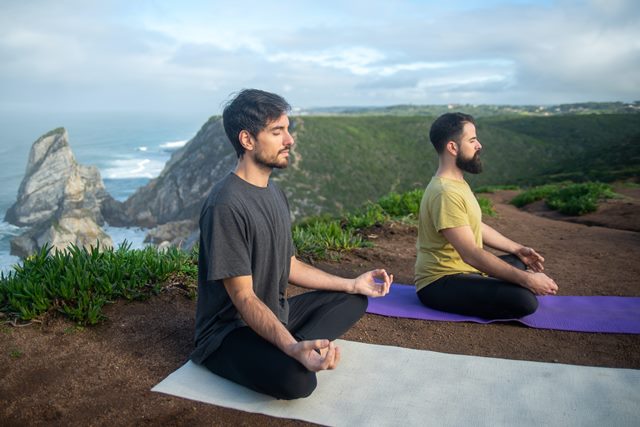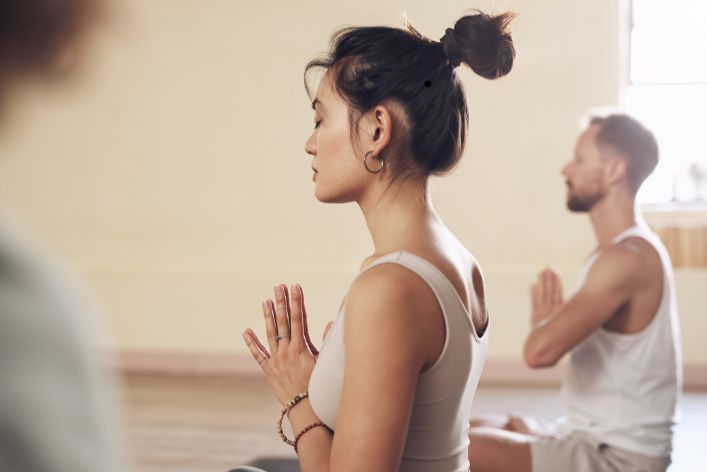Last Updated on May 16, 2023
Are you looking for a way to improve your physical and mental well-being? Look no further than yoga! Yoga has been around for centuries, but its benefits are still being discovered today.
Whether you’re a beginner or an experienced practitioner, incorporating yoga into your routine can significantly impact your health. From reducing stress and anxiety to improving flexibility and balance, the benefits of yoga are truly endless.
So roll out your mat and join us as we explore how yoga can improve your health and enhance your life!

What Is Yoga?
Yoga is a physical, mental, and spiritual practice that originated in ancient India over 5,000 years ago. The word “yoga” comes from the Sanskrit word “yuj,” which means to yoke or unite. In this context, it refers to the union of the body, mind, and spirit.
Yoga is not just a series of physical poses or exercises but a comprehensive system that promotes holistic health and well-being.
It includes breathing techniques, meditation, ethical principles, and physical postures (asanas). All these have been designed to align and strengthen the body, calm the mind, and enhance spiritual awareness.
Yoga is often described as a journey of self-discovery and personal growth, as it encourages practitioners to cultivate a deeper connection with themselves and their surroundings.
It is also a highly adaptable practice that can be modified to suit people of all ages, fitness levels, and backgrounds.
Today, yoga has become increasingly popular and is practiced by millions of people around the world for its many benefits. These include physical fitness, stress reduction, and improved overall health and wellness.
A Brief History of Yoga
As mentioned earlier, yoga’s history can be traced back to ancient India, where it originated over 5,000 years ago. The practice was first mentioned in the Rig Veda, the oldest text of Hinduism, as a way to unite the individual soul with the universal spirit.

Over the centuries, the practice of yoga evolved and became more diverse, with different types emerging to suit different needs and goals.
Some of the most influential texts on yoga include the Yoga Sutras of Patanjali. This provides a framework for the philosophy and practice of yoga, and the Hatha Yoga Pradipika, which focuses on physical postures (asanas).
Various cultural and religious traditions, including Buddhism and Jainism, have also influenced yoga. In the late 1800s and early 1900s, yoga gained popularity in the West as a way to promote physical fitness and mental health.
In the mid-20th century, yoga masters like B.K.S. Iyengar, Pattabhi Jois, and T.K.V. Desikachar helped to popularize yoga in the West, with their respective styles of Iyengar, Ashtanga, and Viniyoga.
Since then, yoga has continued to evolve and adapt to modern times, with new styles and techniques emerging to suit the needs of practitioners.
Read: Yoga vs. Pilates: Which Is Right for You?
Overall Benefits of Yoga for Health and Well-Being
Here are some reasons why yoga is important for health and well-being:
Reduces Stress and Anxiety
One of the most significant benefits of yoga is its ability to reduce stress and anxiety. Practicing yoga promotes relaxation, reduces tension in the body, and calms the mind, which can help to alleviate symptoms of anxiety and depression.
Improves Flexibility and Balance
Yoga poses, or asanas, involve stretching and strengthening different body parts, which can help improve flexibility and balance. This can help to reduce the risk of injuries and improve mobility in daily life.

Boosts Cardiovascular Health
Certain yoga styles, such as Vinyasa and Ashtanga, involve a continuous sequence of postures that can increase heart rate and promote cardiovascular health. This can help to reduce the risk of heart disease and improve overall physical fitness.
Enhances Self-Awareness
Yoga is a practice that promotes self-awareness and mindfulness. By focusing on the breath and body, practitioners learn to tune into their thoughts, feelings, and physical sensations, leading to greater self-awareness and emotional regulation.
Helps Manage Chronic Conditions
Yoga is beneficial for managing chronic conditions like diabetes, asthma, and arthritis. It can help to reduce symptoms, improve quality of life, and enhance overall health and well-being.
Read: Why is Good Posture Crucial for Better Health?
Promotes Better Sleep
Practicing yoga can help to promote better sleep by reducing stress and anxiety, relaxing the body, and promoting a sense of calm and relaxation.
Overall, yoga is an important practice for promoting health and well-being. By incorporating yoga into daily life, individuals can enjoy this ancient practice’s physical, mental, and emotional benefits.
Physical Benefits of Yoga
Yoga is a physical practice that involves a series of postures that can have many physical benefits. Here are some of the physical benefits of practicing yoga:

Increases Flexibility
Yoga postures involve stretching and lengthening muscles, which can improve flexibility and range of motion. This can help to reduce the risk of injury and improve overall physical performance.
Strengthens Muscles
Many yoga poses require holding the body in a particular position, which can help to build strength and tone muscles. This can lead to improved posture, balance, and overall physical strength.
Improves Balance
Yoga postures that involve balancing the body can help to improve balance and stability. This can be especially important for older adults, who may be at risk for falls.
Enhances Respiratory Function
Breathing techniques, or pranayama, are an essential part of yoga practice. Practicing deep, mindful breathing can improve respiratory function, increase lung capacity, and reduce the risk of respiratory conditions like asthma.
Reduces Inflammation
Studies have shown that yoga can reduce inflammation in the body, which can be a contributing factor to chronic health conditions like heart disease and arthritis.
Mental and Emotional Benefits of Yoga
In addition to its physical benefits, yoga is also known for its mental and emotional benefits.

Here are some of the ways that practicing yoga can promote mental and emotional well-being:
Reduces Stress and Anxiety
Yoga is known for its ability to reduce stress and anxiety. By promoting relaxation and reducing tension in the body, yoga can help to calm the mind and alleviate symptoms of anxiety and depression.
Improves Mood
Yoga has been shown to improve mood and promote a greater sense of well-being. This is partly due to the release of endorphins, the body’s natural “feel-good” hormones, during physical activity.
Enhances Self-Awareness
Practicing yoga can help to promote self-awareness and mindfulness. By focusing on the breath and body, practitioners can learn to tune into their thoughts, feelings, and physical sensations. In turn, this can lead to a greater sense of self-awareness and emotional regulation.
Improves Concentration
Yoga requires concentration and focus, which can help to improve mental clarity and cognitive function. This can be especially beneficial for individuals who struggle with attention and concentration.
Promotes Relaxation and Better Sleep
Yoga can help to promote relaxation and better sleep by reducing stress and anxiety, relaxing the body, and promoting a sense of calm and relaxation.
Fosters a Sense of Community
Practicing yoga can be a social activity, which can help to foster a sense of community and belonging. This can be especially important for individuals who feel isolated or disconnected.

What Other Reasons Should You Practice Yoga?
In addition to yoga’s physical, mental, and emotional benefits, several other benefits can come from a regular yoga practice. Here are some additional benefits of yoga:
Boosts Immune System
Studies have shown that yoga can help to boost the immune system by reducing stress and inflammation in the body.
Improves Digestion
Certain yoga postures can help stimulate the digestive system, improving digestion and relieving symptoms of digestive issues like bloating, constipation, and indigestion.
Increases Energy
Vinyasa and power yoga can be physically demanding and can help to increase energy levels by promoting circulation and releasing tension in the body.
Promotes Mind-Body Connection
Yoga can help to promote a greater sense of mind-body connection by encouraging practitioners to tune into their physical sensations and breath. This can be especially beneficial for individuals struggling with dissociation or feeling disconnected from their bodies.
Improves Posture
Practicing yoga can help improve posture by strengthening core muscles and encouraging proper spine alignment.
Enhances Creativity
By promoting relaxation and reducing stress, yoga can help to enhance creativity and promote a greater sense of inspiration and intuition.
Different Types of Yoga and Which One to Choose
There are many different types of yoga, each with its own unique set of postures, breathing techniques, and philosophies.

Here are some of the most popular types of yoga and what they entail:
Hatha Yoga
Hatha yoga is a gentle, slow-paced style that is great for beginners. It focuses on basic postures and breathing techniques and can help to improve flexibility, balance, and overall physical fitness.
Vinyasa Yoga
Vinyasa yoga is a more fast-paced style involving a continuous postural flow. It can help to improve cardiovascular health, build strength, and promote mindfulness.
Ashtanga Yoga
Ashtanga yoga is a physically demanding style that involves a set series of postures practiced in a specific sequence. It can help to build strength, increase flexibility, and promote a sense of discipline and focus.
Iyengar Yoga
Iyengar yoga is a precise and detail-oriented style that emphasizes proper alignment and props like blocks and straps to help practitioners achieve the correct posture. It can help to improve flexibility, strength, and posture.
Bikram Yoga
Bikram yoga, or hot yoga, is practiced in a heated room and involves a sequence of 26 postures. It can help to improve flexibility, strength, and cardiovascular health but may not be suitable for individuals who are sensitive to heat.
Restorative Yoga
Restorative yoga is a gentle, relaxing yoga style that involves long-held postures supported by props like blankets and bolsters. It can help to reduce stress and anxiety and promote deep relaxation.
When choosing a type of yoga, it’s important to consider your personal fitness level, goals, and preferences. You should also consider any health concerns or limitations you may have and consult with a healthcare provider before beginning a new exercise routine.
Before you go…
Hey, thank you for reading this blog to the end. I hope it was helpful. Let me tell you a little bit about Nicholas Idoko Technologies. We help businesses and companies build an online presence by developing web, mobile, desktop, and blockchain applications.
We also help aspiring software developers and programmers learn the skills they need to have a successful career. Take your first step to becoming a programming boss by joining our Learn To Code academy today!
Be sure to contact us if you need more information or have any questions! We are readily available











